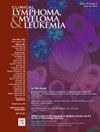Health-Related Quality of Life in Patients With Relapsed/Refractory Multiple Myeloma Treated With Carfilzomib, Dexamethasone, and Daratumumab Versus Carfilzomib and Dexamethasone: An Analysis of Patient-Reported Outcomes From the Phase 3 CANDOR Trial
IF 2.7
4区 医学
Q2 HEMATOLOGY
引用次数: 0
Abstract
Background
In the phase 3 CANDOR trial (NCT03158688), daratumumab added to carfilzomib and dexamethasone (KdD) significantly prolonged progression-free survival relative to carfilzomib and dexamethasone (Kd) alone in previously treated patients with relapsed/refractory multiple myeloma (RRMM).
Materials and Methods
We present a post hoc analysis of the European Organisation for Research and Treatment of Cancer Quality of Life Questionnaire–Core 30-item module (EORTC QLQ-C30) and EORTC QLQ Myeloma 20-item module (EORTC QLQ-MY20) patient-reported outcome (PRO) measures from the CANDOR trial.
Results
Median (range) duration of observation for PROs was 18.4 (0.9-50.0) months (KdD) and 10.3 (0.9-48.4) months (Kd). PRO compliance rates were high and similar between arms. Mean scores on the EORTC QLQ-C30 global health status (GHS)/quality-of-life (QOL) scale were numerically higher in the KdD than in the Kd arm and were generally sustained or trended toward improvement from baseline. Other EORTC QLQ-C30, EORTC QLQ-MY20, and EQ-5D visual analog scale (VAS) scores were generally similar between treatment arms and were stable over time, with some numerical trends favoring KdD. Risks of deterioration were similar for most scales; hazard ratios suggested improvement for KdD for EORTC QLQ-C30 social functioning, EORTC QLQ-MY20 disease symptoms, and EQ-5D VAS. Results were consistent for lenalidomide-exposed and lenalidomide-refractory subgroups. EORTC QLQ-C30 GHS/QOL scores trended toward improvement at some time points, and other scores remained generally stable when daratumumab was added to carfilzomib and dexamethasone.
Conclusion
These results support the benefits of KdD for the RRMM population, including lenalidomide-exposed and lenalidomide-refractory patients.
Clinical Trial Registration
NCT03158688.
卡非佐米、地塞米松和达拉单抗与卡非佐米和地塞米松治疗复发性/难治性多发性骨髓瘤患者的健康相关生活质量:CANDOR 3 期试验的患者报告结果分析。
研究背景在3期CANDOR试验(NCT03158688)中,对于既往接受过治疗的复发/难治性多发性骨髓瘤(RRMM)患者,在卡非佐米和地塞米松(KdD)基础上加用达拉单抗可显著延长无进展生存期:我们对CANDOR试验中的欧洲癌症研究和治疗组织生活质量问卷-核心30项模块(EORTC QLQ-C30)和EORTC QLQ骨髓瘤20项模块(EORTC QLQ-MY20)患者报告结果(PRO)进行了事后分析:患者报告结果(PROs)的中位数(范围)观察时间分别为18.4(0.9-50.0)个月(KdD)和10.3(0.9-48.4)个月(Kd)。两组患者的PRO达标率较高且相似。在 EORTC QLQ-C30 全球健康状况 (GHS) / 生活质量 (QOL) 量表上,KdD 组的平均得分在数值上高于 KdD 组,而且与基线相比,KdD 组的平均得分通常保持不变或呈改善趋势。治疗组之间的其他 EORTC QLQ-C30、EORTC QLQ-MY20 和 EQ-5D 视觉模拟量表 (VAS) 评分基本相似,并且随着时间的推移保持稳定,但有一些数值趋势有利于 KdD。大多数量表的恶化风险相似;危险比显示,KdD改善了EORTC QLQ-C30社会功能、EORTC QLQ-MY20疾病症状和EQ-5D VAS。来那度胺暴露亚组和来那度胺难治亚组的结果一致。在卡非佐米和地塞米松基础上加用达拉单抗后,EORTC QLQ-C30 GHS/QOL评分在某些时间点呈改善趋势,其他评分基本保持稳定:这些结果支持KdD对RRMM人群的益处,包括来那度胺暴露和来那度胺难治患者:临床试验注册:NCT03158688。
本文章由计算机程序翻译,如有差异,请以英文原文为准。
求助全文
约1分钟内获得全文
求助全文
来源期刊

Clinical Lymphoma, Myeloma & Leukemia
ONCOLOGY-HEMATOLOGY
CiteScore
2.70
自引率
3.70%
发文量
1606
审稿时长
26 days
期刊介绍:
Clinical Lymphoma, Myeloma & Leukemia is a peer-reviewed monthly journal that publishes original articles describing various aspects of clinical and translational research of lymphoma, myeloma and leukemia. Clinical Lymphoma, Myeloma & Leukemia is devoted to articles on detection, diagnosis, prevention, and treatment of lymphoma, myeloma, leukemia and related disorders including macroglobulinemia, amyloidosis, and plasma-cell dyscrasias. The main emphasis is on recent scientific developments in all areas related to lymphoma, myeloma and leukemia. Specific areas of interest include clinical research and mechanistic approaches; drug sensitivity and resistance; gene and antisense therapy; pathology, markers, and prognostic indicators; chemoprevention strategies; multimodality therapy; and integration of various approaches.
 求助内容:
求助内容: 应助结果提醒方式:
应助结果提醒方式:


